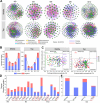Fermentation process of tobacco leaves drives the specific changes of microbial community
- PMID: 39716094
- PMCID: PMC11664857
- DOI: 10.1186/s12866-024-03702-w
Fermentation process of tobacco leaves drives the specific changes of microbial community
Abstract
Background: The changes of microbial community on tobacco leaves are affected by several factors during fermentation. However, the relative contribution of different factors in determining microbial community is not clear. This study investigated the effects of fermentation time (fermentation for 0, 3, 6, 9 and 12 months), leaf position (middle and top tobacco leaves) and fermentation site (Longyan and Xiamen warehouses) on bacterial community of tobacco leaves using 16 S rDNA sequencing.
Results: The results demonstrated that fermentation time had a much stronger impact on bacterial diversity, composition, co-occurrence network and functional profiles than leaf position and fermentation site. With the fermentation progressed, the difference of bacterial community between middle and top tobacco leaves was gradually reduced or even disappeared. The bacterial community diversity and network complexity at three, six and nine months of fermentation were significantly lower than those at fermentation initiation. Specific bacterial genera with desired functions were recruited at different fermentation stages, such as Terribacillus, Pantoea and Franconibacter at three or six months of fermentation and Pseudomonas at nine months of fermentation. The recruited microorganisms would form biofilms on tobacco leaves and compete for polysaccharide or protein substances to accelerate the degradation of tobacco macromolecular substances.
Conclusions: In conclusion, fermentation time was an important factor in determining the composition and function of microbial community on tobacco leaves during the fermentation process.
Keywords: Co-occurrence network; Functional profiles; Microbial community; Plant fermentation; Tobacco leaves.
© 2024. The Author(s).
Conflict of interest statement
Declarations. Ethics approval and consent to participate: Not applicable. Consent for publication: Not applicable. Competing interests: The authors declare no competing interests.
Figures






Similar articles
-
Analysis of bacterial communities on aging flue-cured tobacco leaves by 16S rDNA PCR-DGGE technology.Appl Microbiol Biotechnol. 2007 Jan;73(6):1435-40. doi: 10.1007/s00253-006-0625-x. Epub 2006 Oct 17. Appl Microbiol Biotechnol. 2007. PMID: 17043820
-
Characterization and discrimination of microbial community and co-occurrence patterns in fresh and strong flavor style flue-cured tobacco leaves.Microbiologyopen. 2020 Feb;9(2):e965. doi: 10.1002/mbo3.965. Epub 2019 Dec 5. Microbiologyopen. 2020. PMID: 31808296 Free PMC article.
-
Effects of Exocellobiohydrolase CBHA on Fermentation of Tobacco Leaves.J Microbiol Biotechnol. 2024 Aug 28;34(8):1727-1737. doi: 10.4014/jmb.2404.04028. Epub 2024 Jun 19. J Microbiol Biotechnol. 2024. PMID: 39049482 Free PMC article.
-
Integrated microbiology and metabolomics analysis reveal the fermentation process and the flavor development in cigar tobacco leaf.Microbiol Spectr. 2025 Jun 3;13(6):e0102924. doi: 10.1128/spectrum.01029-24. Epub 2025 Apr 24. Microbiol Spectr. 2025. PMID: 40272187 Free PMC article.
-
Shaping the future of tobacco through microbial insights: a review of advances and applications.Front Bioeng Biotechnol. 2025 May 12;13:1548323. doi: 10.3389/fbioe.2025.1548323. eCollection 2025. Front Bioeng Biotechnol. 2025. PMID: 40421115 Free PMC article. Review.
References
-
- Dai W, Xie D, Lu M, Li P, Lv H, Yang C, et al. Characterization of white tea metabolome: comparison against green and black tea by a nontargeted metabolomics approach. Food Res Int. 2017;96:40–5. 10.1016/j.foodres.2017.03.028. - PubMed
-
- Huang JW, Yang JK, Duan YQ, Gu W, Gong XW, Zhe W, et al. Bacterial diversities on unaged and aging flue-cured tobacco leaves estimated by 16S rRNA sequence analysis. Appl Microbiol Biot. 2010;88(2):553–62. 10.1007/s00253-010-2763-4. - PubMed
-
- Long PP, Wen MC, Granato D, Zhou J, Wu Y, Hou Y, et al. Untargeted and targeted metabolomics reveal the chemical characteristic of pu-erh tea (Camellia assamica) during pile-fermentation. Food Chem. 2020;311:311. 10.1016/j.foodchem.2019.125895. - PubMed
-
- Chen SS, Fu Y, Bian XQ, Zhao M, Zuo YL, Ge YH, et al. Investigation and dynamic profiling of oligopeptides, free amino acids and derivatives during pu-erh tea fermentation by ultra-high performance liquid chromatography tandem mass spectrometry. Food Chem. 2022;371:371. 10.1016/j.foodchem.2021.131176. - PubMed
MeSH terms
Substances
Grants and funding
LinkOut - more resources
Full Text Sources

